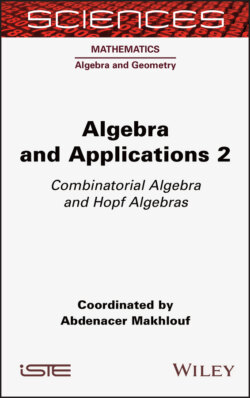Читать книгу Algebra and Applications 2 - Группа авторов - Страница 22
1.3.4. The convolution product
ОглавлениеAn important result is that any connected filtered bialgebra is indeed a filtered Hopf algebra, in the sense that the antipode comes for free. We give a proof of this fact as well as a recursive formula for the antipode using the convolution product: let ℋ be a (connected filtered) bialgebra, and let be any k-algebra (which will be called the target algebra): the convolution product on is given by:
PROPOSITION 1.8.– The map , given by and e(x) = 0 for any x ∈ Ker ε, is a unit for the convolution product. Moreover, the set endowed with the convolution product is a group.
PROOF.– The first statement is straightforward. To prove the second, let us consider the formal series:
Using (e — φ)(1) = 0, we have (e — φ)*k(1) = 0 immediately, and for any x ∈ Ker ε:
[1.17]
When x ∈ ℋn, this expression vanishes and then for k ≥ n + 1. The formal series then ends up with a finite number of terms for any x, which proves the result. □
COROLLARY 1.1.– Any connected filtered bialgebra ℋ is a filtered Hopf algebra. The antipode is defined by:
[1.18]
It is given by S(1) = 1 and recursively by any of the two formulae for x ∈ Ker ε:
[1.19]
[1.20]
PROOF.– The antipode, when it exists, is the inverse of the identity for the convolution product on . We then just need to apply Proposition 1.8 with . The two recursive formulas come directly from the two equalities:
fulfilled by any x ∈ Kerε.
Let be the subspace of formed by the elements α, such that α(1) = 0. It is clearly a subalgebra of for the convolution product. We have:
From now on, we will suppose that the ground field k is of characteristic zero. For any x ∈ ℋn, the exponential:
[1.21]
is a finite sum (ending up at k = n). It is a bijection from onto . Its inverse is given by:
[1.22]
This sum again ends up at k = n for any x ∈ ℋn. Let us introduce a decreasing filtration on :
[1.23]
Clearly, and . We define the valuation val φ of an element φ of as the greatest integer k, such that φ is in . In the sequel we will consider the ultrametric distance on induced by the filtration:
[1.24]
For any let [α, β] = α * β — β * α.
PROPOSITION 1.9.– We have the inclusion:
[1.25]
and moreover, the metric space endowed with the distance defined by [1.24] is complete.
PROOF.– Take any x ∈ ℋp+q − 1, and any and . We have:
Recall that we denote by |x| the minimal n, such that x ∈ ℋn. Since |x1| + |x2| = |x| ≤ p + q — 1, either |x1| ≤ p – 1 or |x2| ≤ q — 1, so the expression vanishes. Now, if (ψn) is a Cauchy sequence in , it is seen immediately that this sequence is locally stationary, that is, for any x ∈ ℋ there exists N(x) ∈ ℕ, such that ψn(x) = ψN (x) (x) for any n ≥ N(x). Then, the limit of (ψn) exists and is clearly defined by:
□
As a corollary, the Lie algebra is pro-nilpotent, in a sense that it is the projective limit of the Lie algebras , which are nilpotent.
